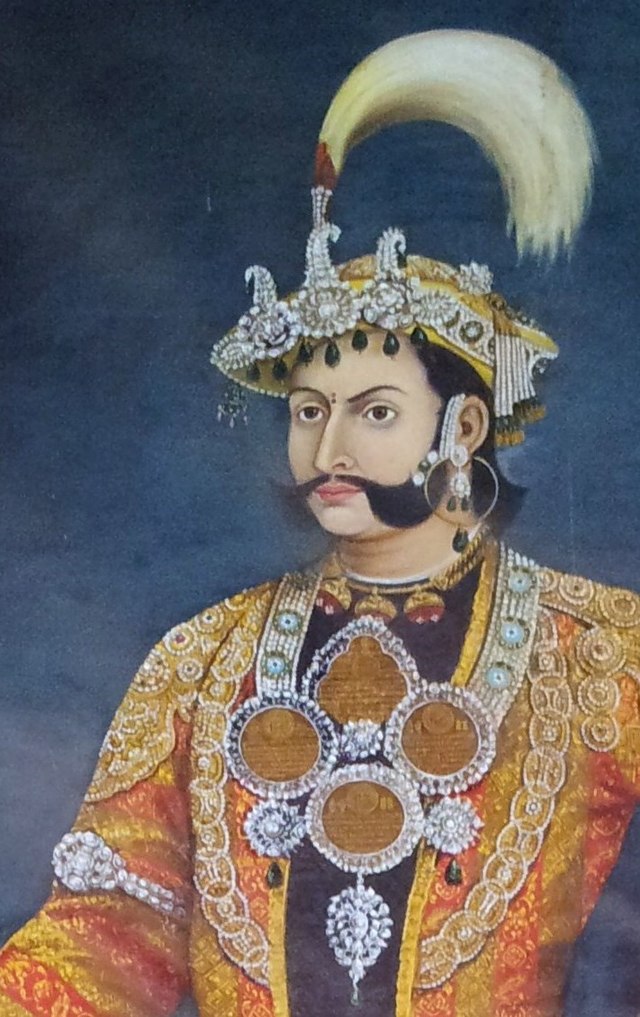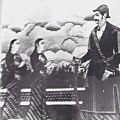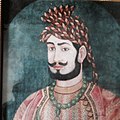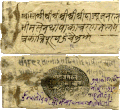Top Qs
Timeline
Chat
Perspective
Thapa dynasty
Political Rajput family of Nepal From Wikipedia, the free encyclopedia
Remove ads
Thapa (नेपाली: थापा) is a historic martial title and family name borne by members of multiple Nepali communities—most prominently the Magar and the Chhetri—and denotes a tradition of military leadership and regional governance from the late medieval period through the 19th century. Its earliest attestations lie in the Magarat confederations of western Nepal, where Thapa-titled chieftains governed hill principalities before and during the unification campaigns of Prithvi Narayan Shah. Over time, distinct lineages of Thapas—both Magar and Chhetri—rose to prominence in the royal court of Kathmandu, served as commanders in the growing Gurkha forces, and played key roles in Nepal’s administration and on global battlefields.

The Thapa family gave rise to the Rana dynasty of Jung Bahadur Kunwar Rana whose father Bal Narsingh Kunwar was the son-in-law of Kaji Nain Singh Thapa. Similarly, this dynasty was connected to the Pande aristocratic family through Nain Singh Thapa who was the son-in-law of once Mulkaji Ranajit Pande[5]
Remove ads
Background
The name Thapa is not exclusive to a single caste or dynasty; it is a historical title and clan name adopted by both Magar and Chhetri communities in Nepal. Rooted in the region’s martial traditions, “Thapa” signified warrior leadership, military command, and local governance.
Among the Magars, Thapa was used by ruling chiefs of the early hill principalities known as the Magarat confederations—independent regions that predated Nepal’s unification. These Magar Thapas were key figures during Prithvi Narayan Shah’s campaigns and later became prominent soldiers in the Gorkhali army and the British Gurkha regiments. In both World Wars, Thapa Magars were highly decorated, and their names dominate Gurkha memorials, such as the one in Italy.
The Chhetri Thapas rose to prominence through Kaji Bir Bhadra Thapa, a commander under King Prithvi Narayan Shah. His descendants, especially Bhimsen Thapa (Mukhtiyar from 1806–1837), led Nepal’s administration and established the Thapa noble family as one of the country’s dominant political houses.
Remove ads
The rise of Thapas (1743–1806)

The family became prominent during the rule of King Prithvi Narayan Shah and were established as a dominant faction during the reign of King Rana Bahadur Shah.[6] After the assassination of King Rana Bahadur Shah, Bhimsen Thapa rose to the event killing all enemies and proving the strength and presence of the Thapa family in the Royal Court of Nepal.[7] He went on to become the second Prime Minister of Nepal[2] and thus founded the Thapa family in the political context of Nepal.[7] Afterwards, the Thapas took the stronghold of the military power with an absolute order, which leads to a rivalry among other nobles.[8]
Remove ads
Thapas on power (1806–1837)
Summarize
Perspective

Tripurasundari was the daughter of Bhimsen's brother, Kazi Nain Singh Thapa.[9] After the chaos that followed King Rana Bahadur's murder, Bhimsen became the Mukhtiyar and his niece Tripurasundari was given the title Lalita Tripurasundari and declared regent and Queen Mother of Nepal.[10] The Thapa family remained in power continuously even after the death of King Girvan Yuddha Bikram Shah and even after the peace deal (Treaty of Sugauli) with the British East India Company done between the then ruling prime minister Bhimsen Thapa representative of Nepal and British.[11] The modernization of the Nepalese Army was done to keep things in control[12] while convincing the suspicious British of no intention to use. Bhimsen increased his family members in court and military and also transferred other aristocratic families away from the capital.[13] Bhimsen instated his youngest brother, General Ranabir Singh Thapa, in the royal palace as chief palace authority.[14] Any meetings between the royal family and commoners or Bhardars were done under his permission and observation.[14]
Thapas remained on political power from the military domination by Bhimsen Thapa. It was no secret that Bhimsen was able to maintain his supremacy due to the large standing army under his and his family's command.[15] Thus, King Rajendra of Nepal feared the Thapa faction as
"...a race of men who for the last fifty-five years have dragged the country and its princes at the wheels of military car."[16]
The downfall of Thapas (1837–1839)
Summarize
Perspective


Bhimsen had committed atrocities against the Pande family by being involved in the execution of Nepalese Chief Kazi Damodar Pande. Rana Jang Pande, the youngest son of Damodar Pande, was a supporter of Senior Queen Samrajya Laxmi and had planned for the downfall of the 31-year Thapa rule.[17] In the Nepalese court, the rivalry between the two queens rose where the Senior Queen supported the Pandes, while the Junior Queen supported the Thapas.[18] Bhimsen went to his ancestral home in Gorkha for some time, making Ranabir Singh Thapa as Acting Mukhtiyar.[19] Rana Jang Pande, the leading member of Pande aristocratic family and his brother, Ranadal Pande, was elevated in the Nepal Darbar.[20]
On 24 July 1837, King Rajendra Bikram Shah's infant son, Devendra Bikram Shah, died.[20][21] Bhimsen and members of the Thapa faction were blamed and conspired against.[21][22][23] On this charge, Bhimsen and whole the Thapa family, the court physicians, Ekdev and Eksurya Upadhyay, and his deputy Bhajuman Baidya, with relatives of the Thapas were incarcerated, proclaimed outcasts, and their properties confiscated.[21][22][24][25]
Fatte Jang Shah, Rangnath Poudel, and the Junior Queen Rajya Laxmi Devi, the anti-Pande faction, obtained from the King the liberation of Bhimsen, Mathabar, and the rest of the party, about eight months after they were incarcerated for the poisoning case.[26][27][28] Confiscation of some properties was pardoned. The pro-Thapa soldiers rallied to Bhimsen, Mathabar Singh, and Sherjung Thapa's houses.[29] Mathabar Singh fled to India while pretending to go on a hunting trip; Ranbir Singh gave up all his property and became a sanyasi, titling himself Swami Abhayananda; but Bhimsen Thapa preferred to remain in his old home in Gorkha.[28][30]
Remove ads
The final chapter of Thapas (1843–1845)
The resurrection of Thapa

Mathabarsingh Thapa fled to India when Bhimsen Thapa and Thapa courtiers were punished.[28][31] Sher Jung Thapa and other jailed Thapa members were pardoned on the request of Junior Queen after the death of Senior Queen.[32] Mathabar, the most senior Thapa, was requested to return to Nepal by then ruling Junior Queen Rajya Laxmi after six years of exile.[33] Mathabarsingh Thapa arrived in Kathmandu Valley on 17 April 1843 where he was greeted with state honors.[34] He then re-opened the murder case of his uncle and godfather Bhimsen Thapa, and members of Pande faction and their supporters were executed.[35]
End of Thapas
The murder of Mathabar Singh on 17 May 1845 by his nephew, Janga Bahadur Kunwar, on the orders of King Rajendra Bikram Shah and his Junior Queen, ended the Thapa family's rule in Nepal giving rise to Agnatic Rana dynasty.[36]
Remove ads
Family palaces

The family resided at Thapathali Durbar and Bagh Durbar. Bagh Durbar was constructed by Bhimsen Thapa, who moved to reside near the Basantapur Palace. He initially moved from Gorkha district to Thapathali Durbar and eventually to Bagh Durbar.[37]

Bagh Durbar, which literally means The Tiger's Mansion, was built in 1805 A.D. by PM Bhimsen Thapa. It had a spacious Janarala Bagh (General's Garden), a pond and many temples glorifying the Mukhtiyar General. When Thapa rule was revived, PM Mathabarsingh Thapa recaptured the lost palace and resided there for two years.[38]


The National Museum of Nepal at Chhauni was once a residence to Prime Minister Bhimsen Thapa. The building has a collection of bronze sculptures, paubha paintings, and weapons including the sword gifted by French Emperor Napoleon I.[39]
Remove ads
Thapa family members
Family Tree of Bir Bhadra Thapa
| Bir Bhadra Thapa | |||||||||||||||||||||||||||||||||||||||||||||||||||||
| Jiwan Thapa | Bangsha Raj Thapa | Satyarupa Maya | Amar Singh Thapa (sanu) | ? | |||||||||||||||||||||||||||||||||||||||||||||||||
| Bhimsen Thapa | Nain Singh Thapa | Bakhtawar Singh Thapa | Amrit Singh Thapa | Ranabir Singh Thapa | Ranbam Thapa | Ranzawar Thapa | |||||||||||||||||||||||||||||||||||||||||||||||
| ? (son died young) | Lalita Devi Pande | Janak Kumari Pande | Dirgha Kumari Pande | ||||||||||||||||||||||||||||||||||||||||||||||||||
Family Tree of Kazi Singh Thapa
| Nain Singh Thapa | Rana Kumari Pande | ||||||||||||||||||||||||||||||||||||
| Ganesh Kumari Kunwar | Queen Tripurasundari of Nepal (born 1794) | Ujir Singh Thapa (born 1796) | Mathabarsingh Thapa (born 1798) | ||||||||||||||||||||||||||||||||||
| Ranojjwal Singh Thapa | Bikram Singh Thapa | Amar Singh Thapa II | Rana Abal Singh Thapa | Ranjor Singh Thapa | |||||||||||||||||||||||||||||||||
Remove ads
Other Thapa nobles
The unrelated family of Amar Singh Thapa was also included in broader Thapa caucus.[4]
Remove ads
Allies and opponents
List of Allies during Transition Phase (1837–1846)
List of Opponents during Transition Phase (1837–1846)
Works

Dharahara tower was built by Mukhtiyar Bhimsen Thapa.[49] Dharahara is said to be built for Queen Tripurasundari of Nepal, who was the niece of Bhimsen Thapa.[50]
Gallery
- Clothes worn by Mukhtiyar Bhimsen Thapa
- Clothes worn by Mukhtiyar Bhimsen Thapa
- Picture of Bhimsen Thapa standing beside a horse
- PM Mathabar Singh Thapa in crown
- Portrait of Mukhtiyar General Bhimsen Thapa
- Portrait of first titled Prime Minister Mathabar Singh Thapa
- Statue of Queen Tripurasundari
- Portrait of Mukhtiyar General Bhimsen Thapa
- Portrait of Colonel Mathabar Singh Thapa from 1831
- Portrait of Mathabar Singh Thapa
- Bhimsen Thapa and two wives
- Mathabar Simha Thapa in Panjabi court
- Portrait of Ranabir Singh Thapa
- Portrait of Ujir Singh Thapa
- Portrait of Ranabir Singh Thapa as Swami Abhayananda
- Bhimsen Thapa,
- General Ranabir Singh Thapa's letter signed by his private black seal sent to Mukhtiyar (PM) Bhimsen Thapa and 2nd Kazi (Deputy PM) Ranadhoj Thapa
- Letter sent to PM Bhimsen Thapa and Kazi Ranadhoj Thapa by (Pvt. seal L to R) Bakhat Singh Sardar, Dalbhanjan Pande (Pande Kazi), Ranabir Singh Thapa, Kaji Narsingh Thapa (Elder Amar Singh Thapa's another son) and sundry captains
- Letter sent to PM Bhimsen Thapa and Kazi Ranadhoj Thapa by then Colonel Mathabar Singh Thapa
Remove ads
See also
Notes
References
External links
Wikiwand - on
Seamless Wikipedia browsing. On steroids.
Remove ads

























